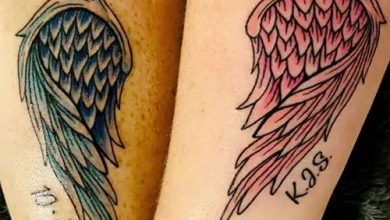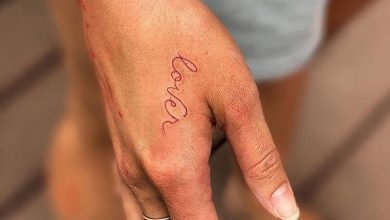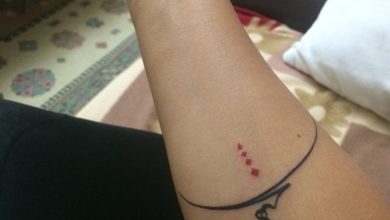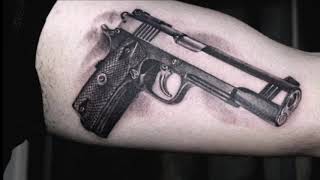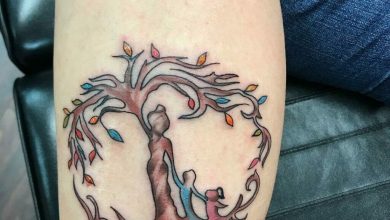Tattoo culture in the 1920s-30s | Art Blart
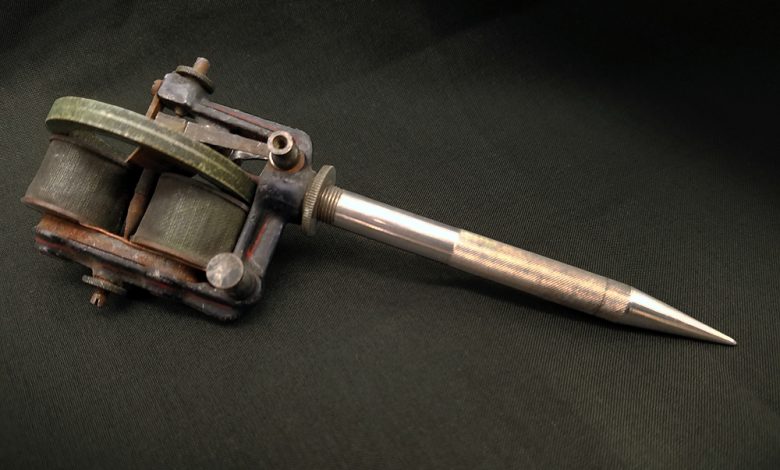
exhibition dates: February 3 – April 30, 2017
Curator: Cristian Petru Panaite, Assistant Curator of Exhibitions at the New York Historical Society

thomas edison (American, 1847-1931) electric ballpoint pen 1876 nickel-plated flywheel, cast iron, steel needle, and electric motor brad fink collection, daredevil tattoo nyc
The first of two posts on the history of tattooing and New York tattoo artists (the second post is on the exhibition The Original Gus Wagner: The Maritime Roots of Modern Tattoo).
“the exhibition focuses special attention on women and tattoos, from the era of fairs to the present day. The photographs capture famous tattooed sideshow stars, including Nora Hildebrandt, “the first professional tattooed woman”; la belle irene, “the original tattooed lady”; and lady viola, “the most beautiful tattooed lady in the world”. A painting by tattoo artist Ace Harlyn depicting famed Bowery tattoo artist Charlie Wagner tattooing Mildred’s helmet – the “first and only female tattoo artist in the Bowery” – shows some of the more than 300 tattoos she created herself. the exhibition also addresses tattooing as an art form that allowed women to challenge gender roles and turn tattoos into signs of empowerment.”
this post includes additional information on featured people and a wonderful song about charlie wagner’s tattoos: the bowery neighborhood, where his studio was located, was “a hotbed of tattoo culture in the 1920s and 1930s “.
enjoy!
dr. marcus bunyan
. many thanks to the new york historical society for allowing me to publish the artwork in the publication. click on the photos to see a larger version of the image.

john simon (English, c. 1675-1751) after john verelst (Dutch, 1648-1734) sa ga yeath qua pieth tow, king of the maquas 1710 mezzotint historical society library from new york
A new exhibition at the New York Historical Society will examine three centuries of tattooing in New York, including the city’s central role in the development of modern tattooing and the successive waves of trends and taboos surrounding the practice. Tattooed New York, on view February 3-April 30, 2017, will feature more than 250 works dating from the early 1700s to the present day: exploring the body art of Native Americans, the art of tattooing practiced by sailors visitors, secondary culture, the 1961 ban that propelled the tattoo underground for three decades, and the post-ban artistic renaissance.
“we are proud to present tattooed new york and offer our visitors an immersive look at the little-known history of modern tattooing,” said dr. Louise Mirrer, President and CEO of the New York Historical Society. “At the convergence of history and pop culture, the exhibition will trace the evolution of this fascinating form of self-expression and the city’s influence on the phenomenon.”
tattooed new york will explore early body art communities such as Native Americans, sailors and soldiers, socialites and “tattooed ladies” and examine how identity is expressed through tattoos today. will follow the evolution of tattoo technology, from punch and poke techniques to machines; trace the rise of New York City’s Bowery neighborhood as a hotbed of tattoo culture in the 1920s and 1930s; share the creative and secret ways tattoos continued during prohibition; and features artwork from some of the best New York tattoo artists working today. Tattooed New York is curated by Cristian Petru Panaite, Assistant Curator of Exhibitions at the New York Historical Society.
new york historical society text


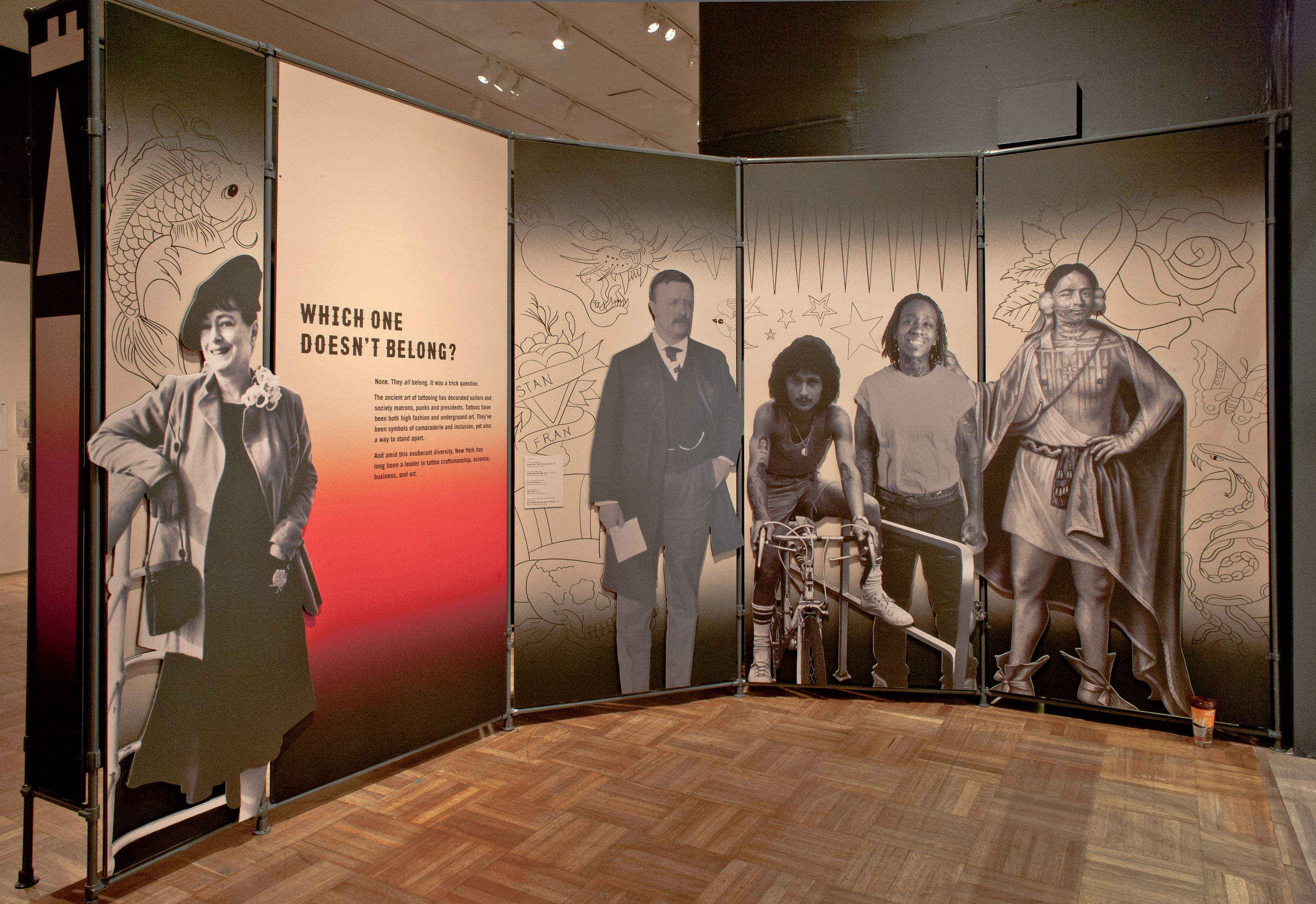

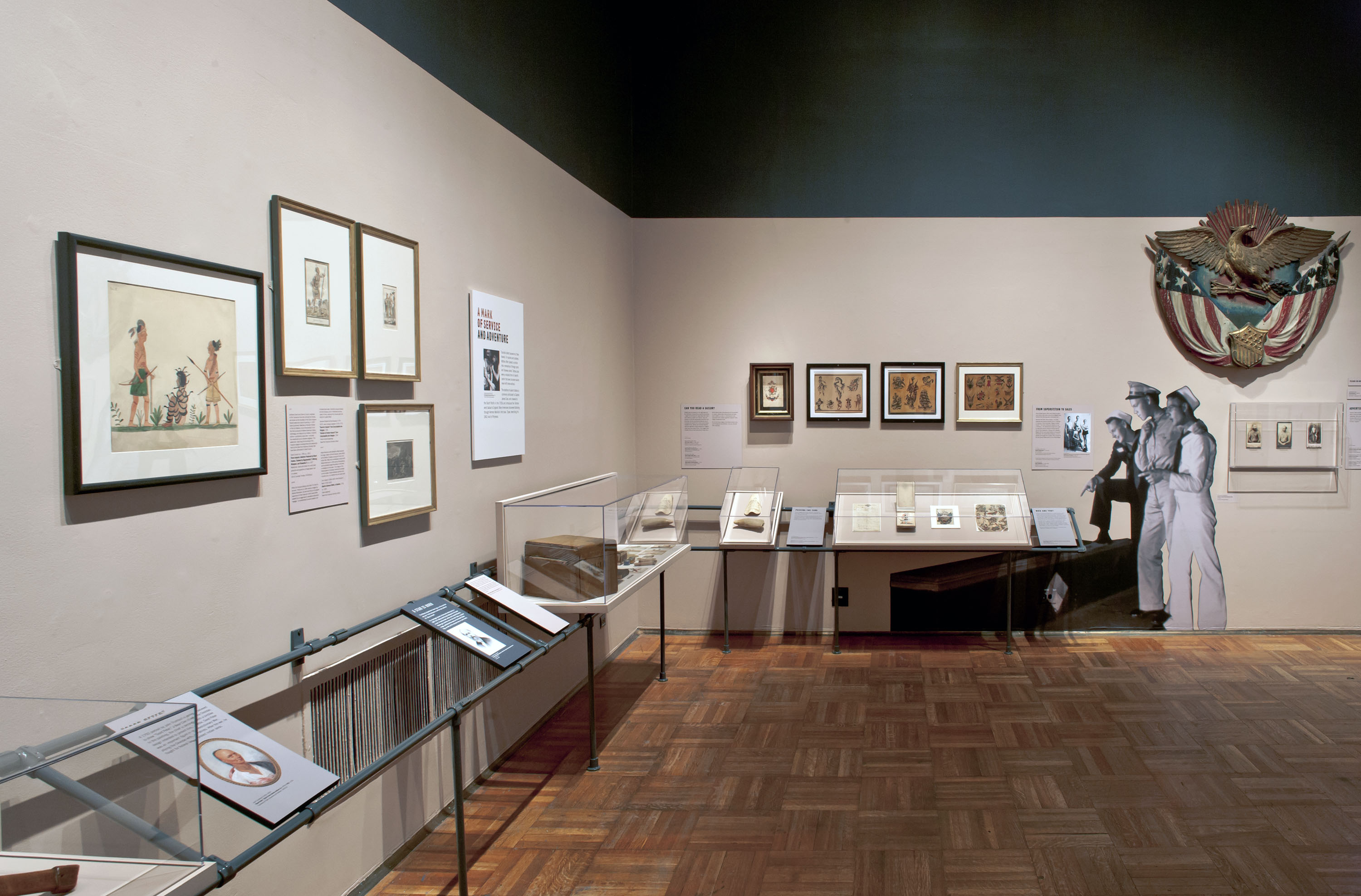


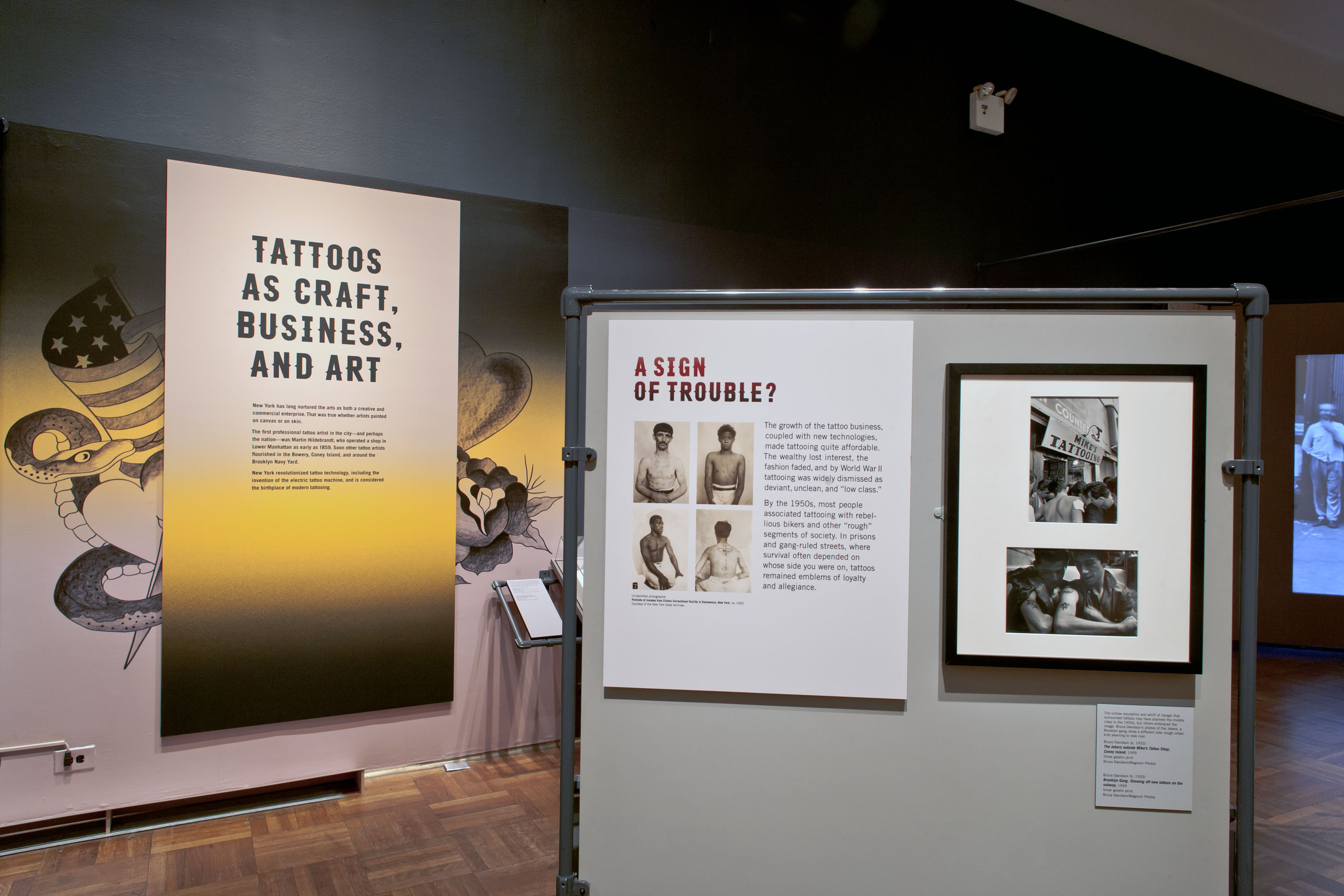
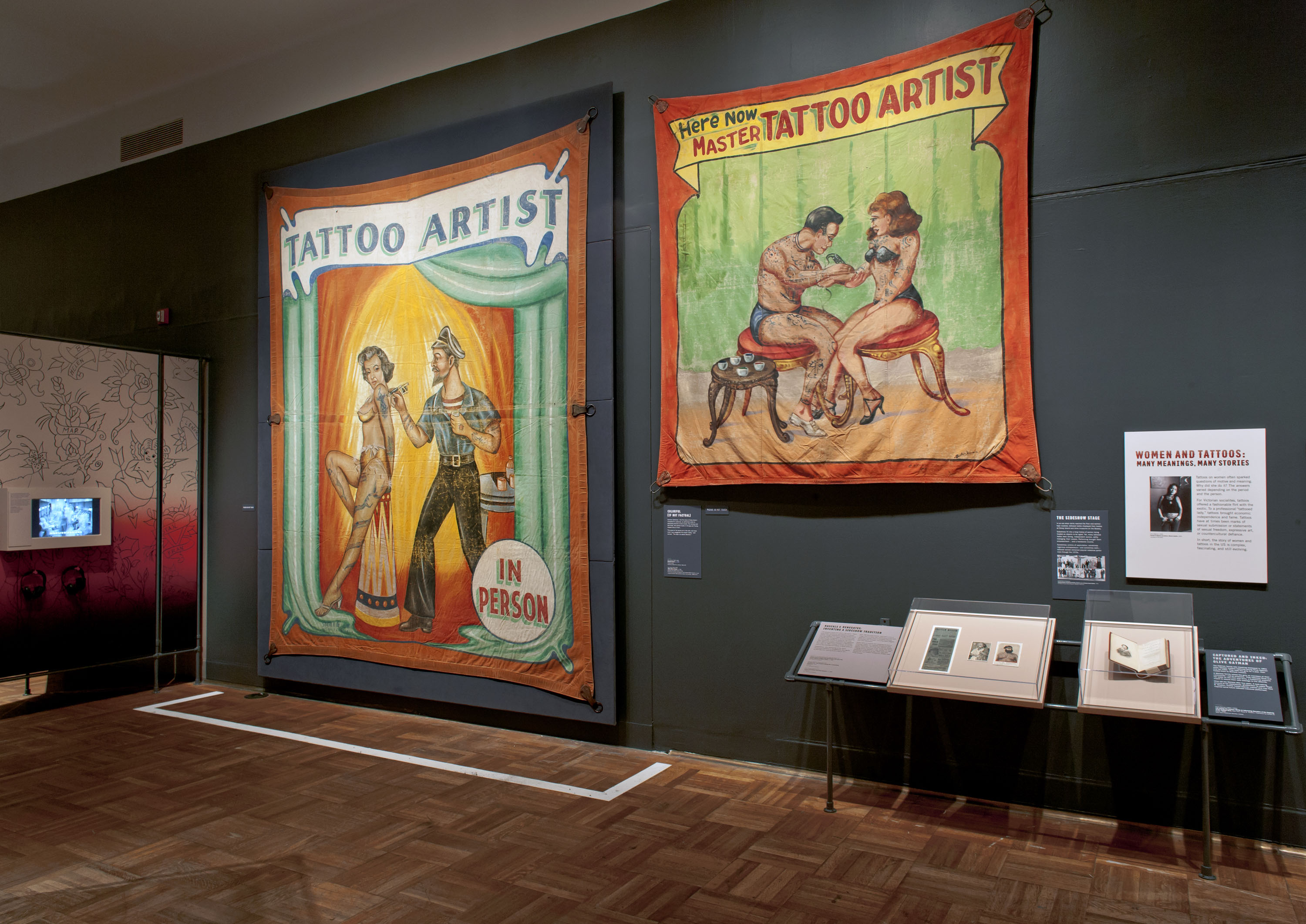

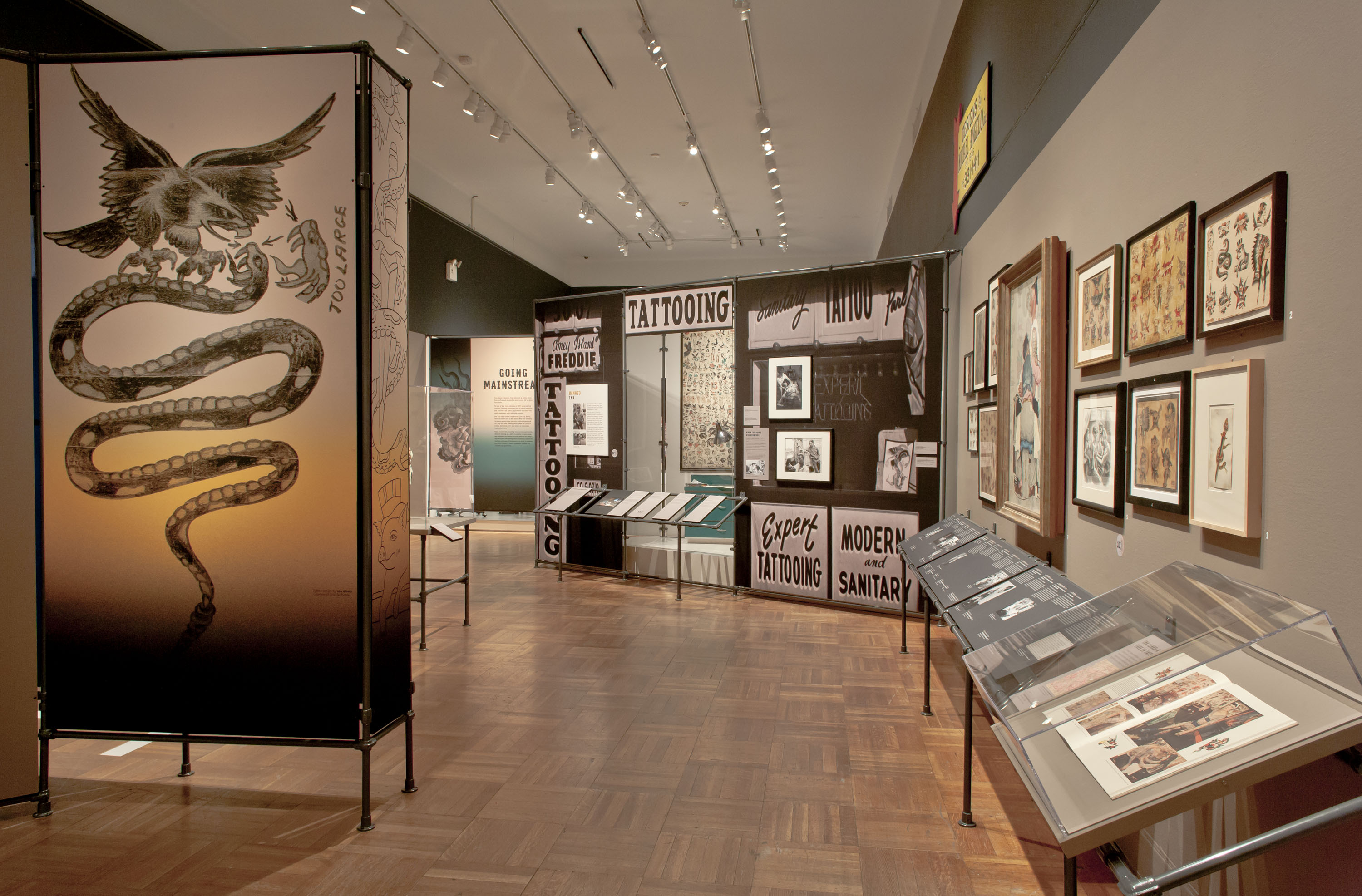









installation views of the exhibition tattooed new york at the new york historical society, new york photos: glenn castellano, new york historical society
exhibition highlights
Among the earliest items in the exhibition are the New York Historical Society’s Four Indian Kings mezzotint from 1710, featuring portraits of Mohawk and Mohican tribal kings who traveled to London seeking military aid against the French and their Ojibwe allies. the king of the maquas (or mohawk tribe) is depicted with black linear patterns covering his chest and lower face. Also on view is a 1706 pictograph of a Seneca merchant depicting his distinctive snake and bird tattoos as his personal signature, one of the earliest recorded in Western accounts. Tattooed New York also features a Native American tattoo team used for medicinal purposes and a mid-18th-century Ojibwe baseball club with carvings suggesting tattoo patterns that likely adorned the warrior’s body.
As soldiers and sailors traveled the world in the early 19th century, tattoos served as reminders of distant lands, good luck charms, and protection against induction into the British Royal Navy. Passing through New York, sailors also earned extra money by showing off their tattoos in pop-up sideshows. An early protection certificate and a manual tattoo kit belonging to a sailor are on display, along with examples of patriotic and religious art that inspired the tattoo designs.
the exhibition traces the evolution of advances in the art of tattooing, many of them started in new york. Martin Hildebrandt, often credited as the first professional tattoo artist in New York City, established a permanent tattoo business in lower Manhattan as early as 1859. The trade was revolutionized by Samuel O’Reilly’s invention of the electric tattoo machine. At the Bowery in 1891 O’Reilly’s machine was based on Thomas Edison’s electric autograph pen, an example of which is on view. the invention instantly made tattooing cheaper, faster, and more accessible. New York tattoo artists also changed the way designs were drawn, marketed, and sold. Flash, the sample tattoo drawings that still adorn many studios today, was developed and popularized by Lew Alberts, whose drawings are featured alongside the work of Bob Wicks, Ed Smith, and the legendary Moskowitz brothers.
The exhibition focuses special attention on women and tattoos, from the days of fairs to the present day. The photographs capture famous tattooed sideshow stars, including Nora Hildebrandt, “the first professional tattooed woman”; la belle irene, “the original tattooed lady”; and lady viola, “the most beautiful tattooed lady in the world”. a painting by tattoo artist ace harlyn depicting famed bowery tattoo artist charlie wagner tattooing mildred’s helmet-the “first and only female tattoo artist in the bowery”-shows some of the over 300 tattoos she created herself . the exhibition also addresses tattooing as an art form that allowed women to challenge gender roles and turn tattoos into signs of empowerment.
In 1961, the new york city health department declared it “illegal for any person to tattoo a human being”, citing hepatitis b as a concern. Prohibition sent tattoo artists underground and many continued to work quietly from their homes, often receiving clients at odd hours of the night. The exhibition features photographs of Thom Devita and Mike Bakaty’s apartment studios and tattoo designs from the period, including some made for quick concealment in the event of random police raids. Also on display will be the work of top artists who began exploring tattoos during the Prohibition years, including Ruth Marten, Mike Bakaty, and Spider Webb.
The ban on tattoos was lifted in February 1997. Today, more than 270 tattoo parlors are flourishing in the five boroughs. The images of the tattoo, filmed for the exhibition in various New York studios, demystify the process. An audio tour invites visitors to hear the voices of the legendary tattoo artists who worked in New York City in the late 20th century. The international reach of New York’s influence on the art world today is demonstrated in the work of tattoo artists from Denmark, Japan, Mexico, China, Brazil, the UK and Italy.
The exhibition closes by showcasing some of the ways New Yorkers today use tattoos to express themselves and empower themselves. tattoos covering mastectomy scars, for example, represent a new beginning for breast cancer survivors. Memorial tattoos worn by 9/11 survivors are a permanent reminder to “never forget.”
new york historical society press release

charles eisenmann (born united states, germany, 1855-1927) nora hildebrandt c. adam woodward 1880 albumen photography collection
“then I start talking about nora hildebrandt, the first “official” tattooed woman. She had a short-lived career at Barnum & bailey’s circus, where she showed off her tattoos on stage. But a woman named Irene Woodward quickly replaced Nora because she was considered more attractive. this relates to the present: how many of the most famous tattoo artists are heavily sexualized, and it relates to how men fetishize the female body. In the 19th century, people visiting freak shows could buy cabinet cards (photographs) of these women and take them home as souvenirs. people would collect them. it was like the instagram followers version of her. both practices relate to the female body being “circulated” and “possessed”.
anni irish cited in zach sokol. “the history of tattooed women, from freak shows to reality TV”, on vice website 2015-05-14 [online] quoted 2021-09-12

unknown photographer la belle irene c. 1880

la belle irene french postcard 1890

unknown photographer la belle irene c. 1880

samuel o’reilly (American, 1854-1909) eagle and shield c. 1875-1905 watercolour, ink and pencil on paper forklift collection project
o’reilly was a new york tattoo artist who patented the first electric tattoo machine on december 8, 1891. he began tattooing in new york in the mid-1880s. o’reilly’s machine was based on thomas edison autograph printing pen rotary technology. Although O’Reilly held the first patent for an electric tattoo machine, tattooists had been experimenting with and modifying a variety of different machines before the patent was issued. O’Reilly’s first pre-patent tattoo machine was a modified dental obturator, which he used to tattoo various ten-cent museum attractions for display between the years of 1889 and 1891. From the late 1880s, tattoo machines continually evolved to become what we now think of as tattoo machine o’reilly first owned a shop at 5 chatham square in the bowery in new york. In 1904, he moved to 11 Chatham Square when the previous tenant, tattoo artist Elmer Getchell, left town. Charles Wagner reportedly apprenticed with O’Reilly and later assumed ownership of his #11 Chatham Square store. On April 29, 1909, Samuel O’Reilly fell while he was painting his house and died. he is buried in the holy cross cemetery, section: st. michaels, rank: 22, grave: 209 brooklyn, kings, ny.
text from wikipedia website
For more information on early tattoo machines, check out the Interesting History of Tattooing webpage
The tattoo industry was “revolutionized overnight,” according to Steve Gilbert’s Tattoo History: A Reference Book, adding that “O’Reilly was inundated with orders and made a small fortune in a few few years”. his electric machine was capable of making many more punctures per minute, and his puncture was more precise, resulting in more precise tattoos and less bleeding for the recipient.
He was not only an innovative craftsman, but prof. O’Reilly would also become the leading tattoo artist of his day. Perhaps the last confirmation of his talent was that even fans of circus tattoos sought his services in order to revive his illustrated bodies. But as tattoos became more popular, these circus tattoo fans were losing business as their inked bodies were no longer so rare.
o’reilly’s most consistent source of customers was the us. navy. In his opinion, an American sailor without a tattoo was “unfit to sail,” according to Albert Parry’s Tattoo: Secrets of a Strange Art. the inventor’s studio was often packed with youngsters looking to be “seaworthy”. A canny salesman, O’Reilly distributed a pamphlet about tattooing us. soldiers fighting in the Spanish-American War. part of this brochure reads: “brave fellows! they had little fear of gunshots and shells in the smoke of battle, and after scrubbing them off, they gloried in their tattoos.”
ray cavanaugh. “o’reilly’s tattoo machine: fine art for the masses”, irish america website april/may 2016 [online] cited 09/12/2021

lady rapes the most beautiful tattooed woman in the world c. 1920
Lady Viola was born on March 27, 1898 in Covington, Kentucky, and her real name is Ethel Martin Vangi. She was tattooed in 1920 by Frank Graf and soon became known as “the most beautiful tattooed woman in the world.” Ella Lady Viola worked in museums and participated in the Thomas Joyland show until she was 73.
read more on the a-z tattoo history website
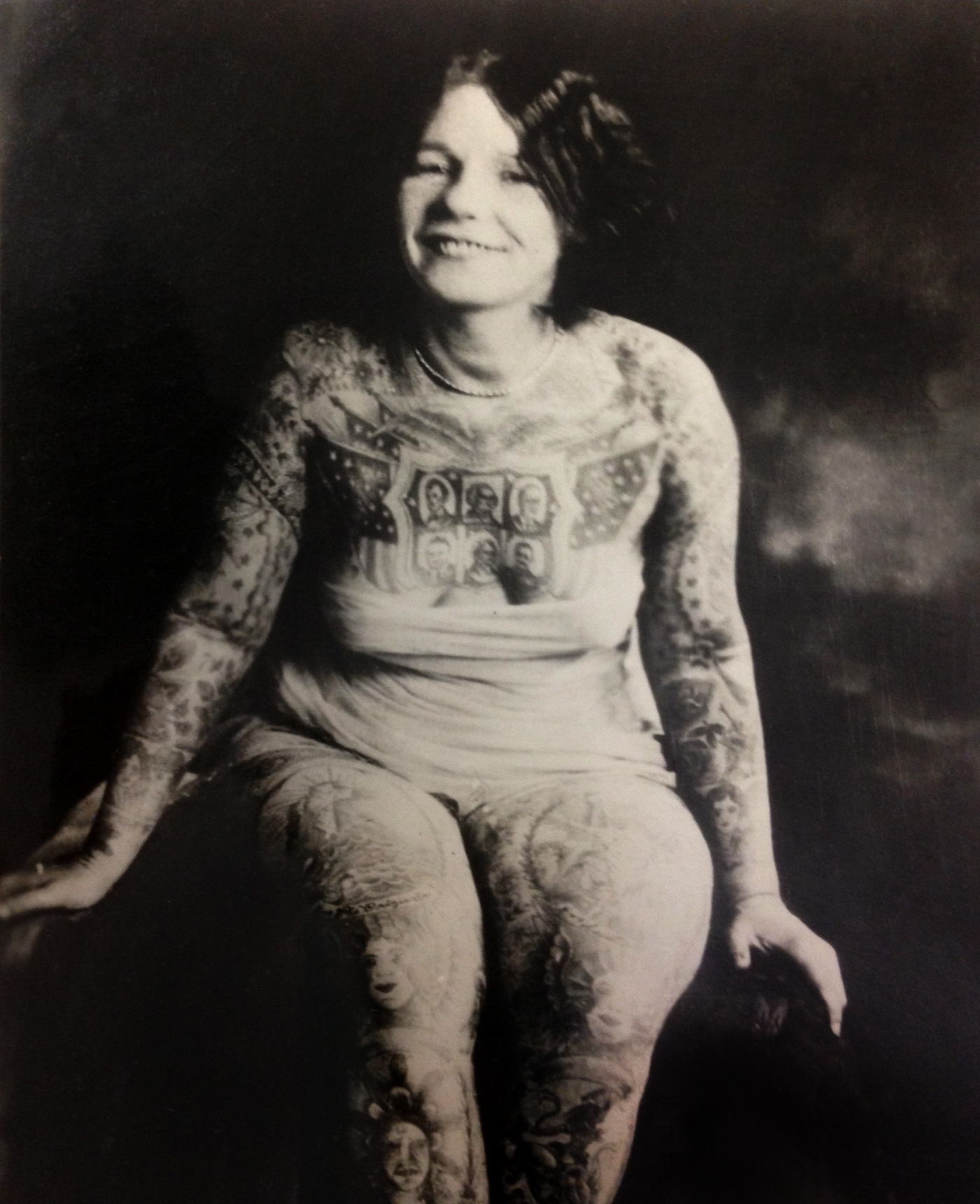
unknown photographer lady viola (ethel vangi) c. 1920

ed smith (American, 1868-1930, active c. 1900-30) self-portrait showing the rock of the ages back piece c. 1920 ink on paper adam woodward collection
charles edward smith, also known as ed smith, was one of boston’s earliest tattoo artists, active from the early 20th century until his death in 1930. not to be confused with new york bowery, denver tattoo artist ed smith.

unidentified maker and charlie wagner (American, 1873-1953) tattoo shop statue of charlie wagner at 11 chatham square c. 1930 polychrome papier-mâché and linen on turned wood base adam woodward collection

bob wicks (American, 1902-1990) flash sheet #36 c. 1930’s pen and watercolor on ohio tattoo museum art board collection

eli jacobi (Russian-born American, 1898-1984) tattoo artist c. 1935 lithograph new york historical society library
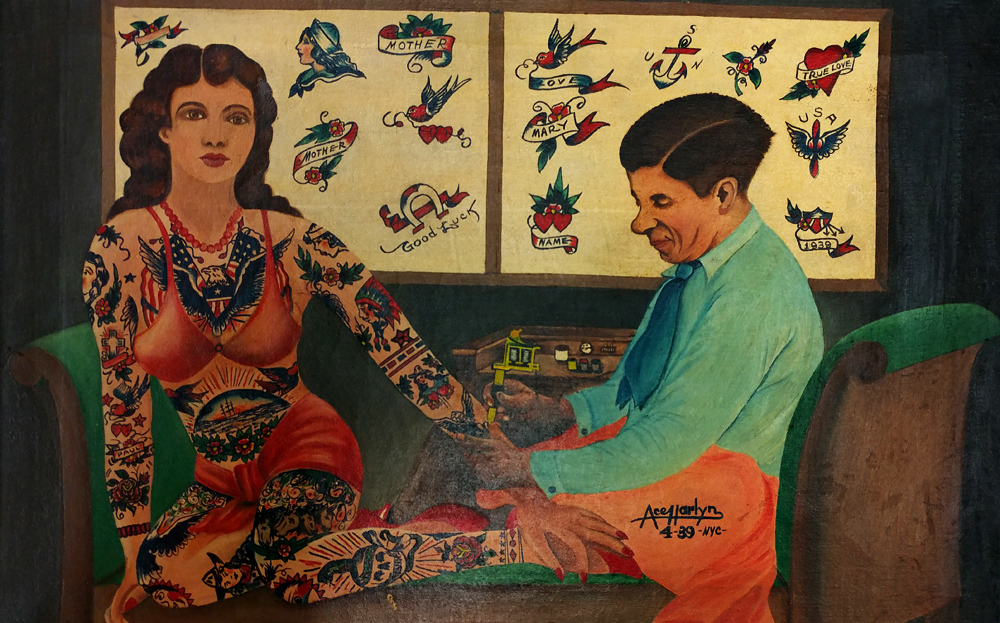
Ace Harlyn (American, active c. 1930-40) Charlie Wagner Tattooing Millie Hull 1939 oil on canvas Brad Fink Collection, Daredevil Tattoo NYC
Mildred Hull, the mother of modern tattooing during the city’s tattoo boom in the early 20th century, was a woman of many talents. Hull, born in 1897, dropped out of school when she was just 13, according to the tattoo file, and then joined the circus [before becoming an exotic dancer]…
According to Unexploded Cities, by 1939, Hull had left the circus and started inking his skin with a little help from his long-time tattoo artist, Charlie Wagner. In the years that followed, Hull elevated her small studio, aptly named the Tattoo Emporium, to one of the most renowned tattoo shops anywhere along that infamous strip of seedy land…
in 1936, the helmet graced the cover of the family circle, tattoos and all, in what became an unprecedented monumental moment in history, one that has hitherto been overlooked . It’s important to note that at the time, the magazine’s primary mission was to provide women with home economics advice.
alex wikoff. “flash from the past: millie hull”, on the tattoodoo website and [online] quoted 09/12/2021

Untitled
unknown photographer [millie hull tattooing in her studio] na
the intersection of bowery, chatham square and division street in what is now new york’s chinatown has seen many changes over the past century, but none influenced the city’s history as much as what happened on those streets at the beginning of the century: the birth of the modern tattoo. The Bowery was home to a host of influential artists who would later become known as the founding fathers of the tattoo community, but among them was a diamond in the rough, “New York’s only female tattoo artist,” Millie Hull. “Millie Hull learned to tattoo from Charlie Wagner at the Bowery,” explains Michelle Myles, artist and co-owner of Daredevil Tattoo and Museum. “I mean, can you imagine how hard that must have been?”
alex wikoff. “flash from the past: millie hull”, on the tattoodoo website and [online] quoted 09/12/2021
captain. don leslie – wagner’s tattooed woman
I first met her in bow’ry at a place called chatham square. It wasn’t her eyes that attracted me, her lips or her pretty hair. It wasn’t her velvet dress or her patent leather shoes, but on her skin she proudly wore Charlie Wagner’s tattoos.
chorus:
well, red roses that she wore on her chest; what a view! oh, the color so vivid, so vivid and bright! and the blues notes danced around her pretty blouse. some say he was a waltz, like johann strauss.
I swear on my son and the gold in my teeth that the memory of that tattooed queen still lingers sweetly. oh she came to charlie there in chatham square to get tattooed by the master there.
well, i left the roundabout at 42, i stopped playing and running, but i always dreamed of that tattooed queen and charlie wagner’s amazing tattoo machines.
chorus:
well, red roses that she wore on her chest; what a view! oh, the color so vivid, so vivid and bright! and the blues notes danced around her pretty blouse. some say he was a waltz, like johann strauss.
I’ve seen beautiful designs like “duel in the sun”, “rock of ages”, battleships and military cannons. well, they all have their place, like a heart with “mama”, but charlie wagner’s tattooed woman is still number one.
all the preachers say: “there is such a beautiful land”. some people call it “heaven” or the “golden staircase”. Well, some people call it “paradise,” and I really don’t care, ’cause I’d rather be in Chatham Square. and, to the right of the throne, a select few: Picasso, Rembrandt, and Michelangelo as well. hey, let me name them all for you, and don’t forget professor wagner too. some painted on canvas and others on the walls of the chapel. his art is worth millions for the fame and all. but charlie wagner is the king of this man’s dreams as he painted the beautiful tattooed queen.
chorus:
well, red roses that she wore on her chest; what a view! oh, the color so vivid, so vivid and bright! and the blues notes danced around her pretty blouse. some say he was a waltz, like johann strauss.
charlie wagner, you are the best and there is no doubt.
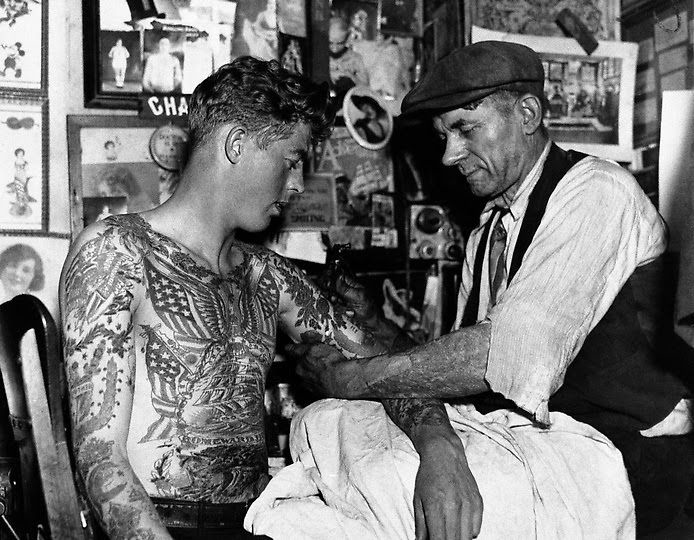
Untitled
unknown photographer [charlie wagner tattooing in his studio] na

unknown photographer jack tyron “painless” tattooed by charlie wagner and lewis (lew) alberts nd
painless tryon jack, also known as “three star jack”, was often billed as the “most tattooed man in the world”. Charlie Wagner and Lew Alberts tattooed him in the early 20th century.
tryon worked as an attraction. Little is known where Tryon learned the art of tattooing, but by the early 1910s he was making a name for himself as a tattoo artist. he was a man of many talents. Bob Shaw remembered Tryon as a wizard, wall climber, hand balancer, and fire eater. Jack’s wife handled snakes and often worked with him. tyron also worked as canvas boss at railway shows like sells-floto in 1923.
while in the united states air force in the late 1940s col. William Todd was stationed in San Antonio, Texas. he recalls that there were “a lot of tattoo shops in san antonio. On the weekends he would visit the tattoo shops and get a small job from a gentleman named Painless Jack Tyron. i started talking to jack and he wanted to buy a machine. he set me up with a little machine, a bottle of color and 4 or 5 air force wing templates and such. I took it to the base, we only go out on Sunday, so on Saturday I was tattooing a group of my friends. I did this for about three weeks. One day the duty officer came in and had me wrap up my things, and he took them to the orderly room and confiscated them. I wanted my machine back and all, but I was afraid to say anything. I left there and never heard anything about it again.”
just a few years later, tryon played a major role in bob shaw’s tattooing career. At the time, Bob was working for Bert Grimm in St. Luis “By the fall of ’48, business was very slow. bert got in touch with an old friend from the circus who was in san antonio, jack tryon painless, and he gave me a job. I went to San Antonio in May 1949.”
it’s interesting that jack tryon had an effect on both bob shaw and col. todd early in their tattoo careers. Shaw and Todd worked together in Clarksville, Tennessee in the 1950s, in Long Beach, California in the 1960s, and together they owned a store in Portland, Oregon in the 1970s. Tex Rowe traveled through San Antonio in the 1940s and remembered tryon as “a tattooed man covered by wagner and albert, and an old fashioned circus tattooist who worked on a vintage circus wagon. he bet me on my first full meal in days and let me sit for a while to earn some ‘walking’ money.”
Originally Posted By Tattoo Archive © 2003 Updated 2017
anonymous text. “”painless” jack tryon”, on tattoo archive website [online] quoted 09/12/2021

irving herzberg (American, 1915-1992) “coney island freddie” tattoo studio just before the tattoo ban in new york city 1961 digital print brooklyn public library
“a jewish tattoo artist, fred grossman (also known as coney island freddie) sued the city for unlawfully destroying his business. (Mike Bakaty, the founder of Fineline Tattoo and an East Village tattoo legend who died last year, told a reporter that Grossman felt the health department’s motive was to “clean up the town” before showing her off at the 1964 World’s Fair. ) Grossman lost, then lost again on appeal. state appeals judge aron steuer (the son of max steuer, my husband’s cousin who defended the triangle factory owners; the new york steuers were clearly lovely people) ruled that the city had the right to decide what was healthy behavior and which one is not. and furthermore, he pointed out, “the so-called decoration of the human body by tattoo designs is, in our culture, a barbaric survival, often associated with a morbid or abnormal personality.” (Another Jewish judge, Samuel Rabin, dissented, saying that “the testimony of the defendants’ medical experts indicates that the practice of tattooing can be safe, if carried out properly in accordance with the proper principles of asepsis. being thus, I am of the opinion that the absolute prohibition of the practice of tattooing is an unjustified extension of police power and, therefore, is not valid “medically correct, but socially unpopular.)”
marjorie ingal. “Jews and tattoos: a new york story”, on the tablet website [online] cited 04/15/2017. is no longer available online

tony d’annessa (b. 1935) blind with bold designs from tony d’annessa’s tattoo shop on w. 48th street c. 1962 ink outline with coloring markers at the tony d’annessa and dave cummings vinyl collection, psc tattoo, montreal
tony tattoo: 83-year-old artist keeps old-school style alive
tony d’annessa might be canada’s oldest tattoo artist. Although now based in the Pointe-Sainte-Charles neighborhood of Montreal, Tony began tattooing in New York City in the 1950s.
see an interview with d’annessa in July 2013 on the san bleu magazine website [online] cited on 12/13/2021

john wyatt (American, b. 1942) thom de vita and client in his studio at 326 e 4th street 1976 gelatin silver courtesy the artist

ruth marten (American, b. 1949) marquesan heads 1977 enamel paint on masonite artist’s collection
ruth marten’s drawings occupy and represent the historical spaces of the old engravings, diverting them with the precision of the tattoo artist. delicate, controlled and highly illusionistic, they use the trope of bad visual props to create an imaginary third space in which surreal and subversive narratives intertwine. Central to Marten’s work is the idea that the visual classification systems and conventions of natural history and encyclopedic illustration are inherently biased and unstable, and she exploits this knowledge to create a surreal and subversive world in which the Phoenicians of hip-hop can coexist with the hirsute. account.
In Marten’s indelible vision, tables are battered by snakes, picnic baskets, and odd forms of horticulture, while a priapic primate holds a giant wig on the back of a marmoset. His drawings map these fantastical spaces with a technical subtlety that makes them seem quasi-scientific: like dishonest illustrations in a Raymond Roussel novel, or key evidence in a pataphysical court of inquiry. By fusing the historical aspects of his chosen prints with contemporary concerns, Marten’s work speaks to us through time, and in doing so, takes the weights, measures, and protocols of the taxonomic process to forge a magical world that is distinctly his own.
“born and living in n.y., ruth marten has worn several hats, hair notwithstanding. From 1972 to 1980 she was a major figure in the tattoo underground and, as one of the few women practicing the craft, she influenced people’s ideas of body decoration. working during the disco and punk era, she also tattooed at the musée d’art moderne de la ville de paris during the 10th biennale de paris in 1977.
hired by jean-paul goude for her first illustration (and for 30 years after) she illustrated books, albums and magazines and is most associated with peter mayle’s “año en provence” books, art directed for a.a.knopf by carol Devine Carson. That love of the printed image informs her most recent interest in changing, through drawing and collage, the setting and content of eighteenth-century prints.”
anonymous text from littlejohn’s contemporary website [online] cited 12/13/2021

maury englander (b. 1943) tattooed family at new york city’s first tattoo convention 1998 digital print © maury englander, all rights reserved
new york historical society 170 central park west at richard gilder way (77th street) new york, ny 10024 phone: (212) 873-3400
hours: wednesday – thursday, saturday – sunday: 11:00 – 17:00 friday: 11:00 – 20:00 monday – tuesday: closed
new york historical society website
I like art blart on facebook
back to top
